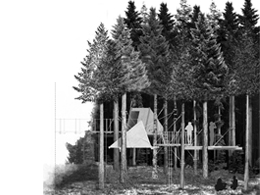STUDENTS PROJECTS
PROJECTS2015

01 July, 2015
In the Woods. Alterable living conditions in an evergreen landscape
Designing four wooden structures on Mount Kallidromo of Fthiotida.
Students : Varvara Gkoufa, Filothei Zisopoulou, Mirto Thanasi
Professor: Andreas Kourkoulas, Panagiotis Vasilatos
N.T.U.A
Presentation date : March 2015
I went to the woods because I wished to live deliberately, to front only the essential facts of life, and see if I could not learn what it had to teach, with this phrase Henry Thoreau sums up the reason that prompted him to live by the lake Walden of Massachusetts for two years, abandoning any contact with the culture of his time. This sentence written in 1854, describes the life in nature with limited resources, away from any amenities. Through this perspective, a mild intervention to the mountain is chosen and aims to facilitate the visitor's experience in nature and protect indirectly the landscape, in the direction of alternative tourism. Thus, a contributory relationship is formed and the visitor is converted from an observer to an active user.
Initially, it was necessary to study a range of different parameters, in order that the proposals could operate in a supporting way to the existing activities of the area, in direct connection with the existing dynamic of the primary sector.

After studying the road network, the most popular hiking routes were recorded, such as they are carried out by the mountaineering associations in the region. These routes ensure the presence of users in the landscape with a non-invasive manner and allow identification of the mountain experientially.
Along the axis Eleftherohori - Mendenitsa, where a concentration of paths is distinguished, a series of small structures is implemented, including staging points, information points, accommodation facilities (camping, shelter) as well as oversight points and fire guardhouses. From this whole axis, the area around Nevropolis was studied in detail, an area that is the core of the proposal, with its theatrical landscape being highlighted as a stage, in which the events unfold.

The construction in the lake is based on the emergence of the volatility of the water element, working inversely from it. Specifically, during the summer months, when the lake water has evaporated, the structure acts as a spouted drinking channel for animals, in which the spring's water is channeled and when the lake is full, it is a passage for walkers, with spring's water being poured at the lake. The linear form of the structure functions as an underlining of the landscape. Regarding its form, the chosen shape is the container in section, the repetition of which forms the channel of 142 meters length and follows the inclination of the lake bottom. This choice creates different relationships between the walker and the water level by altering the angle and the reflection, while the elevation of the floor of the channel allows the passage of the pond water from one side to the other.

As for the camping, it is located on the outskirts of the evergreen forest that surrounds the seasonal lake Nevropolis. Without placing a foreign structural system in the forest's organism, the camping is a structure for it, as it is elevated along the high trunk trees, rising the visitor from the ground level. The entire camp system, due to the variability of its form, reflects the changing seasons, taking the role of a deciduous tree in an unchanged evergreen forest. Specifically, each unit stays open, in order to accommodate visitors during the summer, while in winter, it closes and becomes a staging platform sideways of the raised path.
The form of the camp is defined by the entropy of the forest and the randomness of the logs. Inside the irregular grid of the logs, six dominant axes of movement are selected, while the second level is the net of the beams. Platforms of two or three individuals are arranged on both sides of the main axes, perpendicularly to the secondary beams, in a way that either gathers or diffuses the look.

The third construction concerns the reconstruction of the winter shelter. The basic principle was the creation of a shell which will host 32 users, active in every stage of their stay. Moreover, the aim was to design a shell, which in its rectangular shape will be perceived as a human intervention, while with its low height will underline and will not interfere with the landscape.
Synthetically, the elongated rectangular volume, facing to the south, is located on the node of two paths, but still allows the unhindered passage from its inside. Morphologically, it is composed of a timber frame at a correct angle, which is anchored on one side to three stone walls and, on the other side, to the ground. The framework is formed by the repetition of wooden beams and columns of same dimensions, ensuring the standardization and ease-site assembly of the structure.

In the position of the old fire guardhouse, a new tower is placed for fire protection and observation. Because the construction is placed on a peak, a basic form was selected, that acts as a reference point, without altering the landscape's ridge. It is a triangular prism, which is composed by three vertical planes, of 6 meters width, in a triangular ground plan. This form ensures apart from the vertical signaling of the peak, also, its constant width and its perception as a plane.











